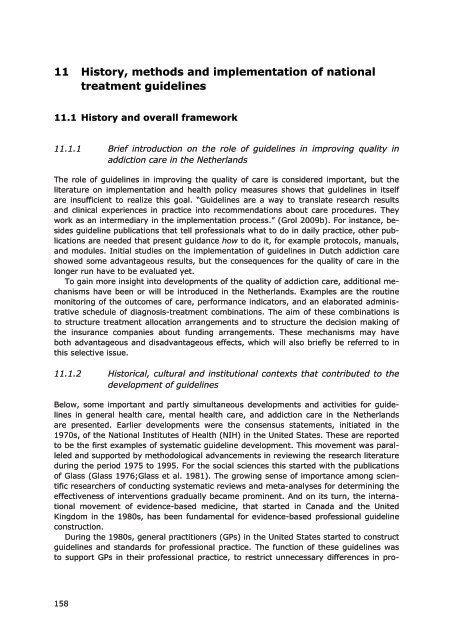The Netherlands Drug Situation 2010 - Trimbos-instituut
The Netherlands Drug Situation 2010 - Trimbos-instituut
The Netherlands Drug Situation 2010 - Trimbos-instituut
You also want an ePaper? Increase the reach of your titles
YUMPU automatically turns print PDFs into web optimized ePapers that Google loves.
11 History, methods and implementation of nationaltreatment guidelines11.1 History and overall framework11.1.1 Brief introduction on the role of guidelines in improving quality inaddiction care in the <strong>Netherlands</strong><strong>The</strong> role of guidelines in improving the quality of care is considered important, but theliterature on implementation and health policy measures shows that guidelines in itselfare insufficient to realize this goal. “Guidelines are a way to translate research resultsand clinical experiences in practice into recommendations about care procedures. <strong>The</strong>ywork as an intermediary in the implementation process.” (Grol 2009b). For instance, besidesguideline publications that tell professionals what to do in daily practice, other publicationsare needed that present guidance how to do it, for example protocols, manuals,and modules. Initial studies on the implementation of guidelines in Dutch addiction careshowed some advantageous results, but the consequences for the quality of care in thelonger run have to be evaluated yet.To gain more insight into developments of the quality of addiction care, additional mechanismshave been or will be introduced in the <strong>Netherlands</strong>. Examples are the routinemonitoring of the outcomes of care, performance indicators, and an elaborated administrativeschedule of diagnosis-treatment combinations. <strong>The</strong> aim of these combinations isto structure treatment allocation arrangements and to structure the decision making ofthe insurance companies about funding arrangements. <strong>The</strong>se mechanisms may haveboth advantageous and disadvantageous effects, which will also briefly be referred to inthis selective issue.11.1.2 Historical, cultural and institutional contexts that contributed to thedevelopment of guidelinesBelow, some important and partly simultaneous developments and activities for guidelinesin general health care, mental health care, and addiction care in the <strong>Netherlands</strong>are presented. Earlier developments were the consensus statements, initiated in the1970s, of the National Institutes of Health (NIH) in the United States. <strong>The</strong>se are reportedto be the first examples of systematic guideline development. This movement was paralleledand supported by methodological advancements in reviewing the research literatureduring the period 1975 to 1995. For the social sciences this started with the publicationsof Glass (Glass 1976;Glass et al. 1981). <strong>The</strong> growing sense of importance among scientificresearchers of conducting systematic reviews and meta-analyses for determining theeffectiveness of interventions gradually became prominent. And on its turn, the internationalmovement of evidence-based medicine, that started in Canada and the UnitedKingdom in the 1980s, has been fundamental for evidence-based professional guidelineconstruction.During the 1980s, general practitioners (GPs) in the United States started to constructguidelines and standards for professional practice. <strong>The</strong> function of these guidelines wasto support GPs in their professional practice, to restrict unnecessary differences in pro-158




